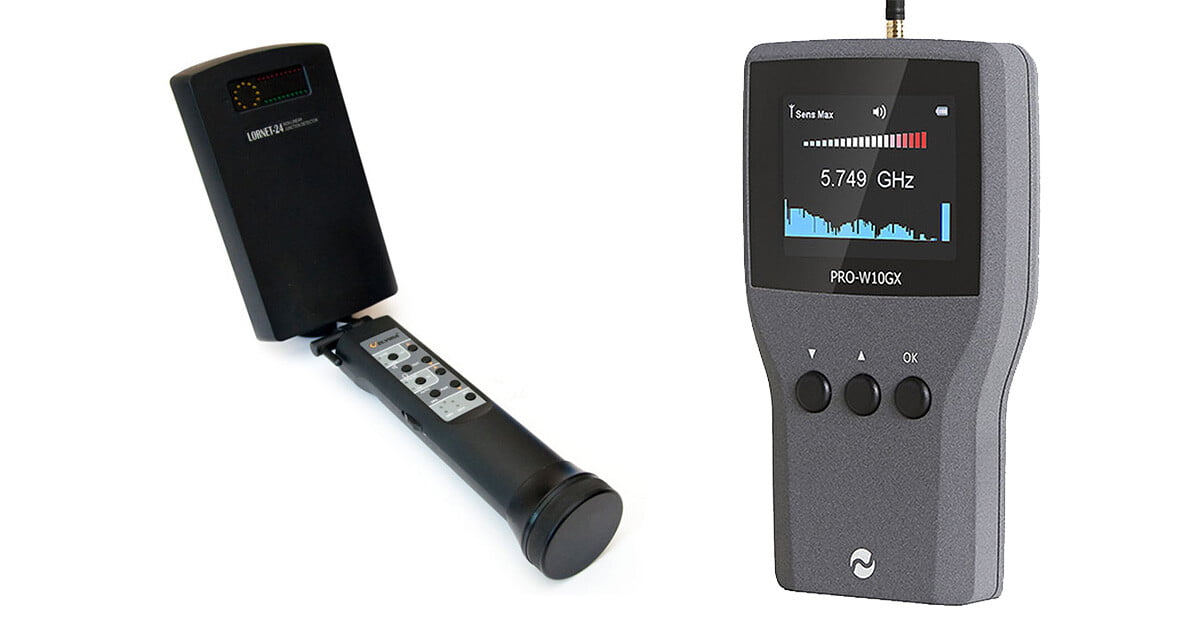
Bug Detection Buyers Guide
Buying a bug detector may not be a sign of paranoia or an unwarranted worry. There are many ways other people can bug your room and tap into your private life.
The head of a screw attached to a wooden cabinet can covertly record your every move and word. Covert listening devices, also known as bugs or wires, can be fitted into small, inconspicuous, everyday items such as pens, calculators, and even shirt buttons.
If you have any suspicions that you might have been bugged by a business competitor or a distrustful spouse, you have to search for those bugs and disable them or knowing where they are you can provide false conversations to them.
You cannot simply look for them as you need a detector to show you where to look. An office block or a normal house would take days to search for with the likelihood of finding it without a bug detector slim at best.
Bug detection is a mix of a quality detector and a keen human eye, without either the process is flawed and you are unlikely to find what you are looking for or you are likely to feel there are bugs everywhere.
Detectors
The first thing to know about Bug Detectors, like most other surveillance technologies is that you get what you pay for. Professionals spend 10s of thousands of dollars on a detector for the primary reason that they detect at a high level.
The majority of people of course could never expect to spend that, however spending $100 or even under that to protect a company or someone in a relationship break-up is probably not worth the investment.
Most detectors over about $400 are handmade, or at least hand tested individually so you know they actually pick up bugging devices. Many below that range are mass produced with turnover in mind second to the unit actually working.
So since Bug detectors range from under $100 to about $10,000, the question begs as to why the price range, yet the cheaper ones seem to cover just as much, if not more.
Well it comes down to the following:
Filters
The first thing that improves with price are filters. Although the cheaper units pick up everything, and we mean everything, the better quality units can filter out ambient signals. For example a cheap unit will pick up a nearby radio station, but a professional unit will know it’s a radio station etc. and allow that to be blocked. This saves you smashing a hole in the wall or dismantling furniture because the local radio station transmission stream appears to come from there.
The other thing a better detector has (from about $200+) is that you have a sensitivity dial. So you can start it up and adjust dial so with ambient signals, the detector is quiet. Then when you get near a device you can clearly see the change. Without a good sensitivity adjustment things can appear quite scary.
Frequency coverage
You really need to get a bug detector that covers from about 1MHz to 6GHz to cover the majority of the risks, however for a serious threat a detector that goes over 20GHz would be recommended.
The better units will have a more defined and accurate frequency range without blind spots. For example we have used detectors made for UK, in Australia they can miss certain 3G areas. This when combined with the new series of GSM bugs being 3G compatible clearly that detector becomes less likely to find some bugs.
Quality/reliability
Most people cannot test to see if a bug detector actually does what it says. At best you can call someone on a cordless phone or mobile and see what happens. Since you are testing only a possible few hundred frequencies out of a possible 25 billion it is hard to know if you are safe and if the detector actually works at all.
Monitoring options or protection mode
Some premium detectors have what is called protection mode and earphones. This allows you to go through all the detections, listen to them and mark as safe. The detector will ignore them in the future and only detect new devices.
A good detector will notify in between a few seconds and a minute or so when a new transmitter is detected making the detection of new devices and burst bugs much easier.
These offer a far greater layer of protection, but come at a price.
Some other features you may find in detection equipment
- Audio plug so you can listen to the bug via earphones from the detector
- Silent mode with vibration
- Silent mode with display
- Signal strength graph which is vital for locating bugging devices
- Protection mode as discussed above
- Rechargeable
- Frequencies from 0.5MHz to 25GHz (and more)
- Robust metal housing as they do get knocked around
Types of bugs
Standard RF Transmitter
A standard RF (radio frequency) transmitter is without doubt the easiest to detect as they constantly pour out a stream of RF which makes them easy to detect and track. These transmitters are most common with low end systems and homemade devices and normally run on VHF and UHF frequencies.
GSM
GSM bugs are harder to detect as they are dormant whilst not transmitting and furthermore the signal is the same as the ambient mobile phone signals in the area.
GSM bugs are widely available online, however most are 2G which is in an end of life cycle in Australia. 3G units are more expensive and less widely used.
A detector that can support a protect mode will be more suitable for these devices.
Wi-Fi
Wi-Fi bugs are also sometimes used and these can be both sometimes easy to detect and sometimes more difficult due to the ambient Wi-Fi signals in your area.
Basically the same rules apply as GSM and burst bugs, however sometimes if you notice a new Wi-Fi device when you scan with your mobile it can be a clue.
Burst
A burst bug has a memory, so generally they record to themselves all day and then transmit the days recording in a short burst. These are harder to detect as they are only transmitting a detectable signal for a short time each day, normally in the early hours whilst people are asleep.
Burst bugs are not as common, but are widely used by a more professional surveillance expert, or someone they advise.
A detector that can support a protect mode will be more suitable for these devices.
Self-recording (retrievable)
Opinions vary about these, but from our experience self-recorders, like voice recorders etc. generally are extremely difficult to detect, however these units need to be accessed every couple of days or so to recharge and extract recordings from.
Most users of these have several units and will visit the location and do a quick swap.
Electronic bug detection in a DIY format is unlikely to detect these, however they are normally placed in an easily accessible place and are at least the size of your thumb so they can be found with a physical search.
Hidden cameras
This subject really needs an article all by itself as the detection of wireless cameras can be more difficult. However if you have a quality detector and purchase a separate lens detector or small hidden camera detector with lens detector (these have an eyepiece to look through which makes lenses shine or even sparkle) then you will have a good shot at finding it.
Basic use
Each and every bug detector has varied and unique features and to get the most out of your new detector you should study it and search the web and YouTube for bug detection techniques.
In the most simplistic form you should follow these rules:
You may not detect some bugs until you are 0.5m away, so put the detector everywhere
The antenna length alters the frequency sensitivity so if you get a detector with telescopic antenna sweep once full extended and once only extended a few inches
Signals are polarised similar to batteries, this means if you are holding the antenna up and the bug is horizontal it will be harder to detect. Always sweep vertically in an arc and then horizontally in an arc. This will cover most angles.
Preparation
A general sweep of the house or office and make note of each signal, then turn off the mains and check again. This will help you identify signals that are affected by turning off the mains.
Most good bugs are independent from power, however some rely on it, so although this will not tell you in a simple yes or no format if there is something there, when some common sense is applied you should quickly discern if a particular device is acting suspiciously.
Some household items will always show up, these may include your flat screen TV, some fridges and other devices. If the item in question still has output after turned off at the power point then further investigation may be required.
